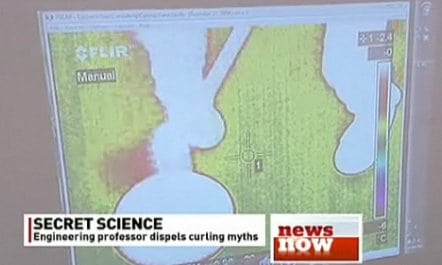By Hamish Johnston
Canadians take curling very seriously — indeed, the CBC has a website dedicated to the sport where you can catch up on the latest results.
In a few days Canada will be hosting the Winter Olympics, and to ensure a bumper crop of medals, the Canadian government has invested CDN$22 million into sports research.
Not surprisingly, some of that money has been spent on studying the physics of curling.
In this TV clip, you can watch Tom Jenkyn of the University of Western Ontario use an infrared camera to study the effect of “sweeping” on the temperature of ice.
For any non-curlers, the sport involves sliding large polished rocks along a sheet of ice and towards a target. Each rock is guided to the target by two sweepers who brush the ice in front of the rock. Sweeping makes the ice more slippery and is used to make the rock go further and to also to modify its “curl” — or its tendency to swerve off a straight line.
Jenkyn discovered that — contrary to popular belief — even the most vigorous sweeping does not melt the ice in front of the rock. Rather, it raises its temperature by about 1.5 degrees, which is enough to affect the motion of the rock.
In the video clip Jenkyn claims to have made dozens of other discoveries that could boost Canada’s curling fortunes at the Olympics — but he’s sworn to secrecy until June, well after the games and the curling season are over.
While most of his findings will only benefit serious competitors, Jenkyn has also designed a new type of broom that is to be commercialized and available to one and all.




